Tiny little almost invisible compounds that you come into contact with on a daily basis have the potential to wreak havoc on your thyroid.
If you’re a thyroid patient then it sounds like something out of a nightmare, but in this case, it’s reality.
These compounds are known as endocrine disrupters (1) or endocrine disrupting compounds and they are all around us.
And pretty much no matter what, you are coming into contact with them on a daily basis.
The good news is that our bodies have built-in mechanisms to take care of them.
The bad news is that these mechanisms aren’t always functioning at 100% in thyroid patients because the thyroid can impact them.
The result?
It’s a lot easier than you might think for these compounds to slowly build up in your system over time where they can eventually cause problems like changes to your thyroid lab tests, changes in how your thyroid hormone works at the cellular level, and more.
I know what you might be thinking:
“This sort of thing may exist but it’s actually not that big of a deal”.
I wish you were right, but that doesn’t seem to be the case which is why major organizations like the Endocrine Society have come out with detailed papers (2) outlining exactly how these compounds are a problem and what they are doing inside of the body.
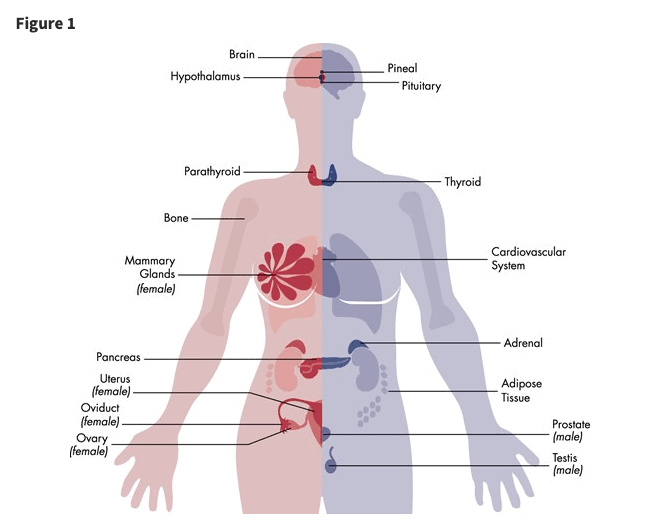
The problem is that this stuff can get really complicated really quickly, especially because these compounds are interfering with enzymes, proteins, and receptors inside cells.
What I’m going to do is simplify the information so it’s a lot easier to understand so you get the most important points:
#1. Where these things are coming from (so you can avoid them).
#2. How they are impacting your thyroid (so you know what to look for).
And #3. How to accelerate the elimination of these EDCs from your body so that they don’t cause issues.
Sound good? Let’s jump in…
What are Endocrine Disruptors?
Put simply, endocrine disruptors are chemical compounds, either man-made or naturally occurring, which interfere with the body’s hormones.
The term endocrine refers to the hormones in the body and the word disruptor just means something that causes problems.
So, in essence, the term is self-explanatory.
What isn’t self-explanatory is how these things cause problems in your body, which is much more complicated.
But if you know a little bit about how hormones are supposed to work (3) then it’s easy to reverse-engineer how these chemicals cause problems.
In the healthy setting, hormones are released from certain tissues in your body where they are sent to the bloodstream.
The blood acts as a highway that carries these hormones to all of the tissues in your body.
Once they arrive, they are shuttled into the nucleus of individual cells where they change the production of enzymes and proteins which then do all of the things that that hormone is supposed to.
In the case of your thyroid, these proteins and enzymes help (4) with hair growth, manage your metabolism, help you think clearly, and so on.
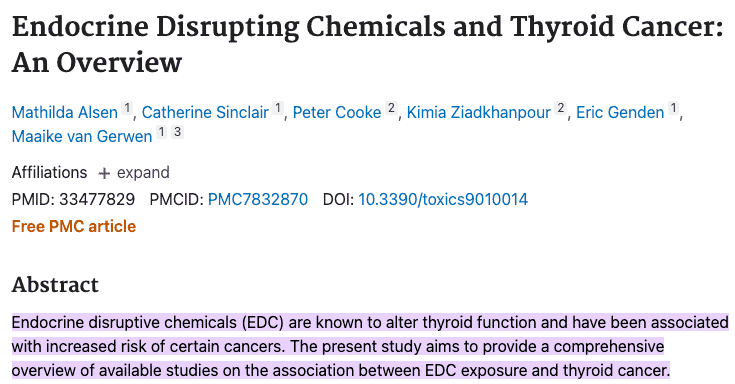
To manage the number of these hormones your body also breaks them down to either recycle them or eliminate them via urine or stool.
That’s how it happens in a healthy state.
But that’s not what happens when your body is exposed to endocrine disruptors.
These disruptors interfere with different parts of the process I mentioned above and depending on where they interfere, they can cause different issues.
For instance, we know that endocrine disruptors can sit on hormone receptors and block your actual hormones from doing their job.
Sort of like sticking a pencil tip in a keyhole and breaking it off.
With the piece of lead stuck in there, it’s hard to stick the real key inside.
And that’s just the beginning, they can cause a whole lot of other problems which we will be talking about below.
DOWNLOAD FREE RESOURCES
Foods to Avoid if you Have Thyroid Problems:
I’ve found that these 10 foods cause the most problems for thyroid patients. Learn which foods you should avoid if you have thyroid disease of any type.
The Complete List of Thyroid Lab tests:
The list includes optimal ranges, normal ranges, and the complete list of tests you need to diagnose and manage thyroid disease correctly!
Endocrine Disruptors that are Known to Cause Thyroid Problems:
We are going to talk specifically about EDCs which interfere with your thyroid but please realize that these hormones are not just causing thyroid problems.
These compounds also have the potential to interfere with sex hormones like estrogen, progesterone, and testosterone as well.
But because my blog is primarily dedicated to helping those with thyroid conditions, we are going to focus on that aspect.
We will go through the top #7 most important EDCs, how they cause problems, and where they are found so that you can hopefully limit your exposure to them.
The more you limit your exposure, the easier they are to eliminate and the fewer problems they will cause.
#1. Polychlorinated Biphenyls (PCBs)

First on the list is polychlorinated biphenyls which are often abbreviated as PCBs.
These chemical compounds are industrial chemicals (used for things like electrical insulators, capacitors, television sets, and refrigerators) that are frequently found in animal and human tissues despite their production being banned in the 1970s.
They have an extremely long half-life ranging anywhere from 4.6 years to 41 years (5) which means that if you came into contact with these chemicals are you were growing up then there’s a high chance they are still in your body.
Remember:
It takes 5 half-lives for something to be eliminated from the body so you can multiply 4.6 and 41 by 5 to get an idea as to how long these chemicals have the potential to stick around.
Because of their widespread use in the past, they are also frequently found in the environment so people are still being exposed to them.
How do they affect your thyroid?
There are mixed results from different studies but several have shown that they alter (reduce) circulating levels of T4 and T3 thyroid hormone (6).
They also have the potential to act as either a thyroid receptor agonist or antagonist.
In simple terms, PCBs sit on the thyroid hormone receptor and either activate it or inactivate it depending on the situation.
In addition, they also result in depressed thyroid hormone levels which can cause low thyroid symptoms.
How can you avoid PCBs?
Even though they are no longer being manufactured, PCBs can still be found in the environment due to spills and leaks, improper disposal of materials, or improper storage.
Because of their long half-lives, they are likely to stick around impacting humans for decades to come.
Low levels of PCBs can be found in fish, shellfish, meat, poultry, milk, and dairy products.
In general, the higher up an animal is on the food chain the higher the PCB level you will find.
The good news is that the levels in the environment have been steadily declining but it will be a while before they are completely eliminated.
Nowadays, most people are exposed to PCBs through food, water, air, or at work (depending on occupation).
#2. Organocholorine pesticides
Like PCBs, organochlorine pesticides are another case of a chemical that was used previously that is still causing problems to this day.
Organochlorine pesticides (OCPs) were used heavily as a way to kill insects from the 1940s to the 1960s.
They were used both in crops and to kill mosquitos to prevent malaria.
While OCPs were highly effective at killing mosquitos, it was later found that they were also highly toxic to humans and animals.
The most famous OCP is DDT which was used on crops (7) but was later found to significantly interfere with the reproductive ability of fish and birds.

Unfortunately, by the time it was known to cause problems, billions of pounds of this compound had already been released into the environment.
And, guess what?
Because of its long half-life (anywhere from 60 days to 15 years), it can still be found in our environment and in humans.
OCPs are not being used in developed countries but there are still countries that use them to help control diseases like malaria.
For these reasons, it’s going to stick around for a while causing problems.
As it relates to your thyroid, we know that some OCPs have the potential to upregulate enzymes in your liver which are responsible for metabolizing thyroid hormones.
The upregulation of these enzymes means that thyroid hormone has less time to do its job in its target tissues which means it will put pressure on your thyroid gland to constantly produce more.
This isn’t a problem for people without thyroid disease but if your thyroid is already struggling because of something like Hashimoto’s, then it may be enough to tip you into a low thyroid state.
Even at low levels (8), OCPs have the potential to impact thyroid hormone levels in pregnant women.
#3. PBDEs (flame retardants)
PBDEs, also known as polybrominated diphenyl ethers, were primarily used as flame retardants.
PBDEs are no longer being produced in the United States but, like the other chemicals we have discussed, they can still be found in the environment.
Because these chemicals don’t dissolve in water they end up settling at the bottom of bodies of water as sediment (9) which can then be picked up by marine animals.
If humans eat these animals then they end up in our bodies as well.
Humans also come into contact with these chemicals by breathing contaminated air or swallowing contaminated dust.
Studies dating back to the early 2000s have shown that over ten different types of PBDEs were found in participants aged 12 years and older.
In short? These compounds are probably in most of us reading this right now.
The question as to whether or not they cause problems for humans is another story.

Whether or not they cause issues probably has to do with your personal ability to metabolize them, your thyroid status, the amount found in your body, and other factors like your current health status.
Even though they may not cause problems for everyone, it’s still a good idea to avoid them as much as possible and to try and eliminate them from your body.
PBDEs impact your thyroid by binding to thyroid hormone receptors (which means your own thyroid gland can’t do its job) and by displacing T4 from binding proteins in the bloodstream.
This means it’s hard to move thyroid hormones around your blood (the highways) to get them to target tissues and, once they are there, they still have a hard time activating cells because of the receptor issue.
#4. BPA

BPA, which stands for bisphenol A (10), is different from the other compounds that we’ve talked about so far because it’s still around and being used.
BPA is frequently found in plastics and epoxy resins which are used for things like water bottles.
If you’ve purchased water bottles anytime within the last 10 years then I’m sure you’ve seen BPA-free being used as a marketing tactic by many of them.
BPAs are also frequently found on thermal paper used for receipts in grocery stores.
In fact, there was a big push to get Target to switch to BPA-free thermal paper and they officially made the switch in 2020 citing “There is growing concern – backed by studies – about the negative health effects of handling BPA (Bisphenol A) and BPS (Bisphenol S) chemicals found in standard thermal receipt paper”.
Why is BPA still around?
Currently, the FDA has said that BPA is safe at the low levels that it’s currently found in foods.
I have no doubt that this statement is largely true for most people, but thyroid patients aren’t most people, and their needs are different.
Even though the FDA considered low doses of BPA safe, I still think it’s a good idea to actively avoid it if you have a thyroid problem.
It may be the case that the FDA is just plain wrong and we will soon find out with more research.
Or it may be the case that most people have problems with BPA and it’s just a select few people who have issues who need to be careful.
Either way, why would you knowingly put something into your body that may cause problems if you don’t have to?
My philosophy is to just do your best to actively avoid it while also doing your best to help eliminate any compounds that accidentally make their way into your body.
Better to be safe than sorry.
When it comes to your thyroid, BPA has been shown to antagonize the thyroid hormone receptor.
It may also negatively impact thyroid hormone creation (in the thyroid gland), the transport out of your thyroid gland, and its metabolism in cells and other tissues (11).
How to avoid BPA:
- Use BPA-free products: look for products that market themselves as BPA-free.
- Avoid heating up plastic containers, water bottles, etc.: heating up plastics may break down BPA compounds and cause them to enter your food or water.
- Use glass as much as possible (instead of plastic): use glass containers to drink and store your water and to store your food.
- Avoid touching or handling receipts as much as possible: have the cashier put your receipt directly into your bag or just go paperless.
#5. Perchlorate & Thiocyanate
Perchlorate is a chemical used in all sorts of things such as fireworks, road flares, explosives, and rocket fuel, and it can also be found naturally occurring in things like rainwater, snow, and groundwater.
It is considered to be ubiquitous which means it’s all around us and there’s probably no getting away from it.
When scientists go looking for perchlorate, they find it in just about every single person they test (12).
Perchlorate is another one of those chemicals that is still around and its exact impact on humans is not well understood.
It was used in the past to treat hyperthyroidism in high doses because of its anti-thyroid effects but that practice has since been abandoned.
Perchlorate is a known inhibitor of the sodium-iodide symporter (13) found in the membrane of thyroid cells.
The job of this symporter is to move iodine into the thyroid gland so that it can create thyroid hormones.
Shutting down this symporter for even a short amount of time can greatly reduce how much thyroid hormone your body is able to produce.
If you can’t produce thyroid hormone then you will end up hypothyroid.
The impact that perchlorate has on your thyroid gland is likely proportional to your exposure.
The good news is that while most humans alive have been exposed, that exposure is usually limited.
Exposure occurs through eating contaminated foods, inhaling contaminated air, and primarily through drinking water.
Since it’s difficult to avoid perchlorate the best strategy is probably one of focusing on elimination rather than exposure.
#6. Triclosan
Triclosan is an antibacterial agent that is frequently used in pretty much anything that is claimed to be antibacterial dating back prior to 2016 (this date will become important in just a minute).
This includes things like hand soap, detergents, skin cleansers, deodorants, lotions, creams, toothpaste, mouthwash, and dishwashing liquids, and was also added to cutting boards, clothing, and plastics.
In 2016, the FDA banned the use of triclosan from household products and prevented companies from marketing this ingredient in over-the-counter healthcare products.
The reason was two-fold:
#1. The widespread use of this antibacterial agent was causing the rise of antibiotic-resistant bacteria in hospitals (14).
And #2. The official statement by the FDA (15) was that those people who were using triclosan failed to prove that it was safe for humans to use.
For these reasons, triclosan is no longer used as frequently as it once was.
This sort of action from the FDA isn’t uncommon once you understand how it operates.
What many people don’t understand about the FDA is that it’s more of a reactionary entity.
This means that often the FDA will sit back to watch and wait until they see that something causes a problem.
Once enough evidence has mounted (or complaints) the FDA will come out swinging as it did with triclosan.
For this reason, just because the FDA hasn’t made any recommendations against the use of something (like perchlorate or BPA) doesn’t automatically mean it’s safe.
The impact triclosan has on thyroid function is mixed with some studies showing it has a negative impact and others showing it has no impact (16).
When it does have a negative impact, it exerts those negative effects on free thyroid hormones like T4 and T3.
Because the FDA has banned the use of triclosan from anti-bacterial soap and liquid (the most likely place of exposure), you should focus more on elimination than exposure.
It is still, however, a good idea to just use regular nontoxic soap and water to wash your hands.
#7. Isoflavones
For the most part, we’ve talked primarily about man-made chemicals which cause disruption of thyroid function.
Soy isoflavones are a little bit different because they are naturally occurring and found primarily in foods.
But just because they are found in foods doesn’t mean they are necessarily helpful for the thyroid gland.
Soy isoflavones have a known impact on thyroid function.
We know this because soy-based baby formulas require the addition of iodine to compensate for the high soy content.
And if you’ve been around the block with your thyroid condition for any number of years, you are probably well aware of the dietary recommendation to avoid soy.
Whether to avoid soy-based food products is a little more complicated compared to the other topics we’ve discussed thus far because there have been studies that show that soy is also beneficial for overall health (17) (which makes sense because it’s food based).
The problem is that even though it may be good for your overall health, doesn’t mean it’s necessarily good for your thyroid health.
Soy isoflavones, the compound that has estrogenic and anti-thyroid effects, is probably best avoided if you have a thyroid problem for 3 main reasons:
- Most food-based sources of soy are highly processed and genetically modified.
- Soy has a powerful estrogenic effect which can make women with already high levels of estrogen worse.
- Soy acts as a goitrogen and may limit the uptake of iodine into the thyroid gland.
None of these are deal breakers, though, because each one can sort of be countered.
For instance, eating an organic form of soy probably solves the genetically modified problem.
And simply consuming more iodine in your diet may counteract its goitrogenic effects.
The estrogenic component is more difficult to bypass but it may not be an issue for every single woman.
For now, though, I still think it’s best for most thyroid patients to avoid soy for the reasons listed above.
Help Eliminate EDCs with These Tips
What should you do if you feel you’ve been exposed to these chemicals (which is likely) and you want to do your best to get rid of them?
Well, you really have two things that you should be doing:
The first is practicing active avoidance to reduce your exposure as much as possible.
You can do this by:
- Simply being aware of these compounds, where they come from, and how they enter your body.
- Drinking filtered water whenever possible.
- Avoiding exposure to plastics, chemicals, and compounds as much as possible.
- Using some common sense tactics like staying away from caustic chemicals that have an obviously obnoxious smell, feel, or taste.
- Store your food in glass instead of plastics.
- Avoid non-stick pans.
- Purchase organic foods whenever possible.
- Avoid chemicals, dyes, preservatives, binders, and fillers in supplements, medications, and foods.
These simple tricks will help you significantly reduce your exposure to these potentially harmful chemicals.
But what if you were already exposed? What then?
By virtue of how thyroid hormone impacts several systems in your body, it’s often harder for thyroid patients to eliminate these compounds.
What you can do is augment the systems that already exist in your body to help this process move along.
Here’s how:
- Undergo a deep sweat at least 3-5 times per week. Sweating is one of the primary mechanisms by which your body eliminates toxins and chemicals that shouldn’t be there.
- Use a FAR IR sauna 3-5 times per week. Saunas increase your body temperature which activates heat shock proteins (18) that assist in the removal of chemicals.
- Drink plenty of filtered water. Drinking filtered will help you urinate more frequently which in turn will provide you with another avenue of eliminating these chemicals.
- Eat foods that help activate liver enzymes. Foods that contain naturally high amounts of sulfur can be used by the liver to augment phase 2 detoxification (19). Foods in this category include eggs, broccoli, cauliflower, and cabbage.
- Exercise regularly. Regular exercise will help you sweat but also help augment your lymphatic system which is another way your body gets cellular waste back into circulation for elimination.
- Ensure you have at least one bowel movement per day. Lastly, your stool is another easy way to eliminate harmful byproducts. You should aim to have at least 1 bowel movement every day.
Final Thoughts
It’s unlikely that these chemicals are putting a huge drag on your thyroid gland but they certainly have the potential to.
When you couple this with the fact that it’s really never a bad idea to avoid exposure to unnecessary chemicals, exercise every day, eat healthy food, and drink filtered water, there’s really no reason why you shouldn’t be doing these things.
At worst, they will only help you feel better and at best they will help you feel much better.
Now I want to hear from you:
Were you aware of these chemical compounds and their negative effects on the thyroid gland?
Do you think you’ve had exposure to any of them based on your lifestyle or occupation?
Are you already practicing active avoidance of these chemicals? If not, are you planning to?
Are you planning on increasing how much you exercise or sweat to help your body eliminate them?
Leave your questions or comments below!
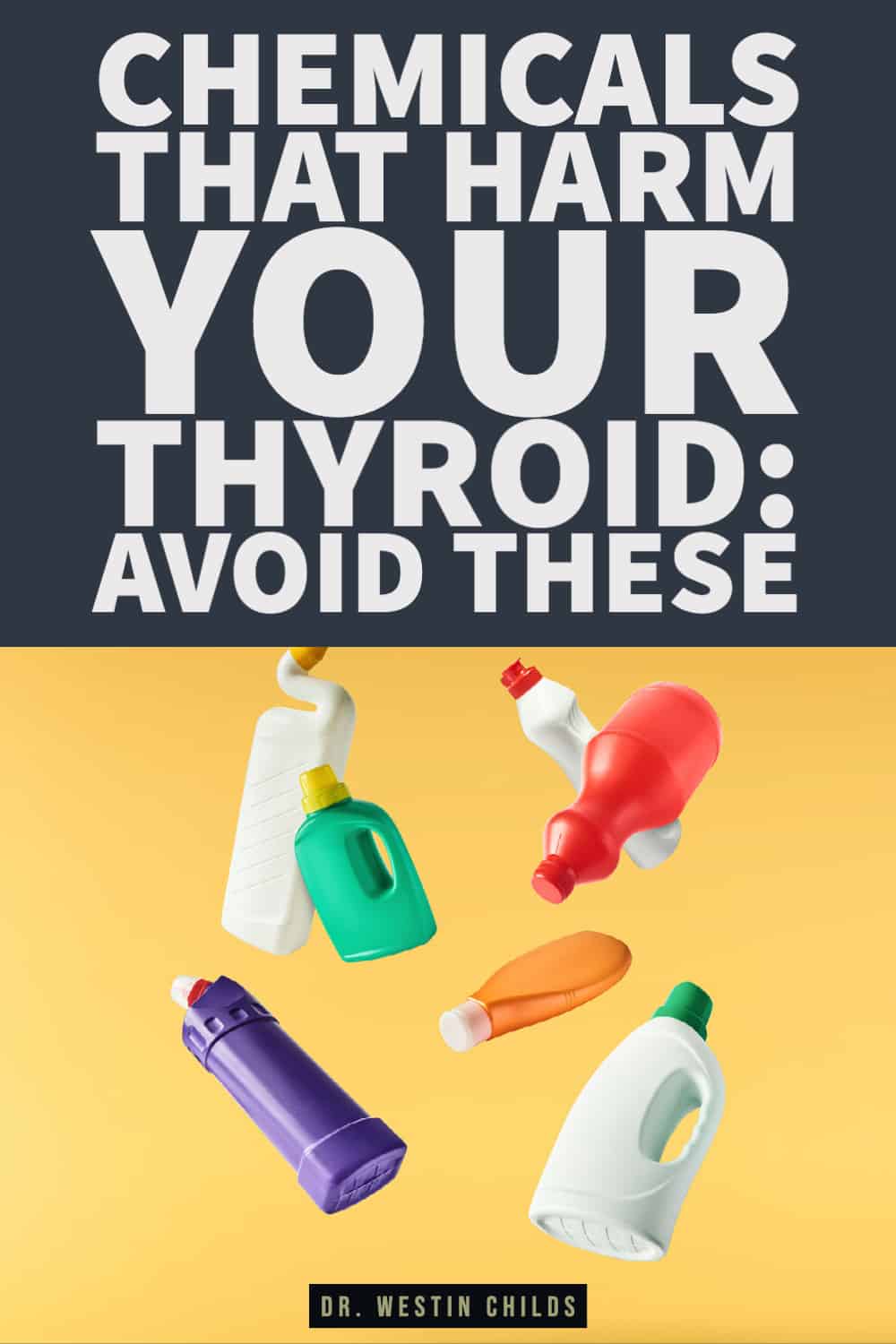
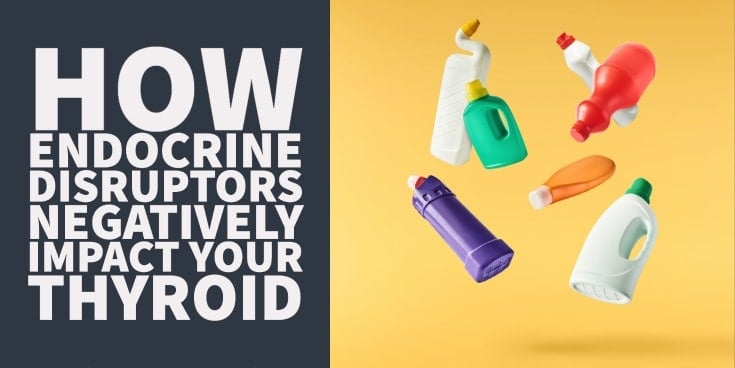

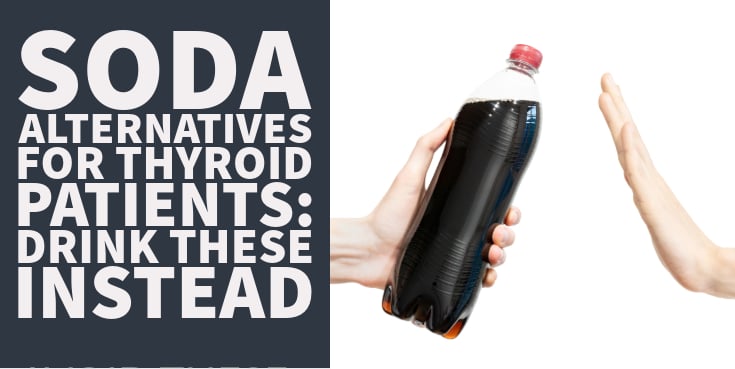
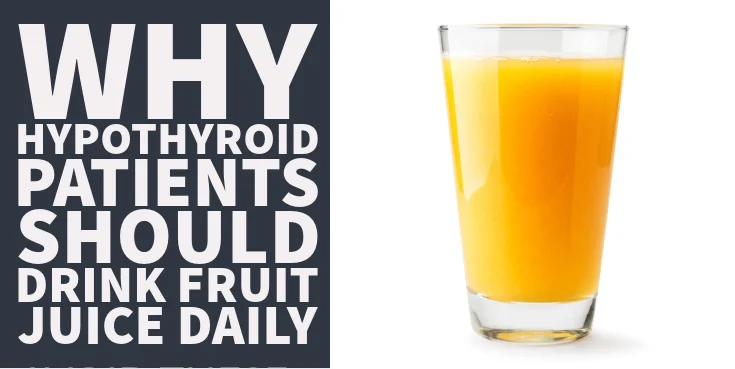
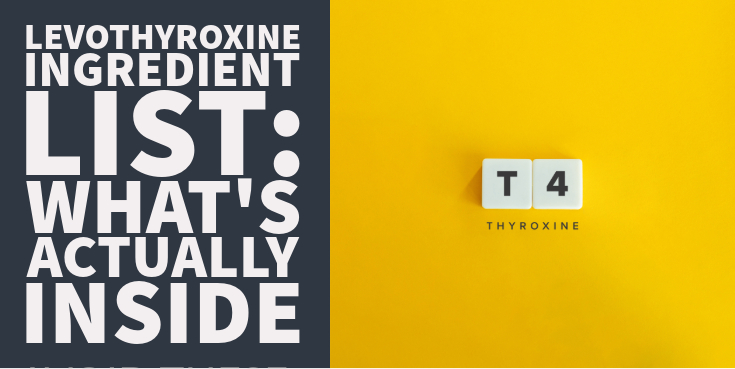
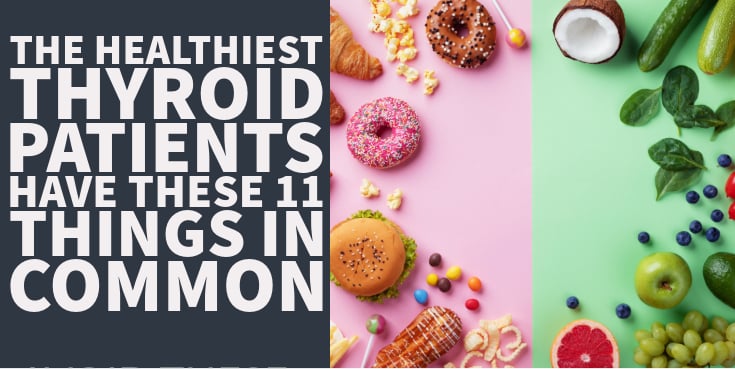
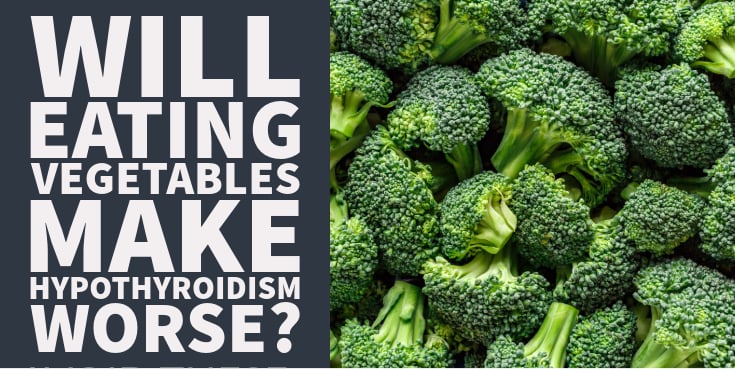

hi Dr Childs
do you have time to email me?
I’m having bizarre symptoms and I think it’s stemming from my thyroid (that I haven’t been taking care of),
Megan
meganp@duck.com
west palm beach
florida
Hi Megan,
The best way to get in touch with me is by leaving a comment on my blog posts or on social media! I do my best to answer every single one. I’m not able to answer every single question/comment due to volume but I do my best to get to as many as possible.
Hi there, I have always wondered if we are getting exposure to BPA and other toxins through the lids of take-away coffee cups. Especially as it is a hot liquid passing through the drinking hole, straight into our mouths ! I always take the lid off and risk the spill……Have you found any evidence or studies on this ?
Hi Heidi,
I’m not familiar with any studies on that exact mechanism but I do know that heating up plastics in a microwave does increase the release of certain EDCs.
In the article above under #4 you say:
Use glass as much as possible (instead of plastic): use plastic contains to drink and store your water and to store your food.
This is a confusing statement for me – maybe I am reading it wrong or not understanding the wording By restating “use plastic containers to drink and store water” it makes me, the reader feel as though you are recommending this practice
Hi Mary,
Thanks for bringing that to my attention! It has been updated and fixed. The statement should read: Use glass as much as possible (instead of plastic): use glass containers to drink and store your water and to store your food.
Dr Westin Childs, this article caught my attention immediately after this pass year I had severe reaction to miracle grow which causes uvulitis. Trip ER at 2am. Treated benadryl ,presidone, as well as antibiotics . Which in turn had 2nd allergic reaction next day to antibiotic treatment. Never have I ever experienced any adverse effects from either substance which I used frequently throughout my life.
So many chemicals, toxic in air, in every day items, actions we take for granted ,using plastic water bottles, unfiltered water, plastic vs glass, microwave, antibacterial usage.
I plan sharing information with family & friends .
Thank you Dr Childs for thyroid health for a happy healthy life!
Annie S
Hi Annie,
Sorry to hear about your recent struggles but thanks for sharing! Glad you found the information helpful.
I moved into a rental house back in November of 2022 and within weeks I began to have bizarre health issues and strange symptoms. An array of symptoms, one being my endocrine system. I found out that there have been water leaks in the house which has caused black mold to grow. Black mold is a big endocrine disrupter. When I move out of this house I will require special treatment from a specialized health care professional to remove the mycotoxins from my body and brain.I am trying very hard to find another rental, but the prices of them are so high at this time and beyond what I can afford. I will keep looking.
Good morning Dr. Childs
Does living in the South help? We sweat here constantly due to humidity. Would this count as excreting these chemicals?
Hi Dr Child’s!
Are the hair color products could be one of these disruptors?
And therefore be part of the painful migraine I’m suffering?
Thank you very much for your admirable and helpful work!
Hi Francoise,
It depends on which one you are looking at but, in general, yes, many hair coloring products contain EDCs.